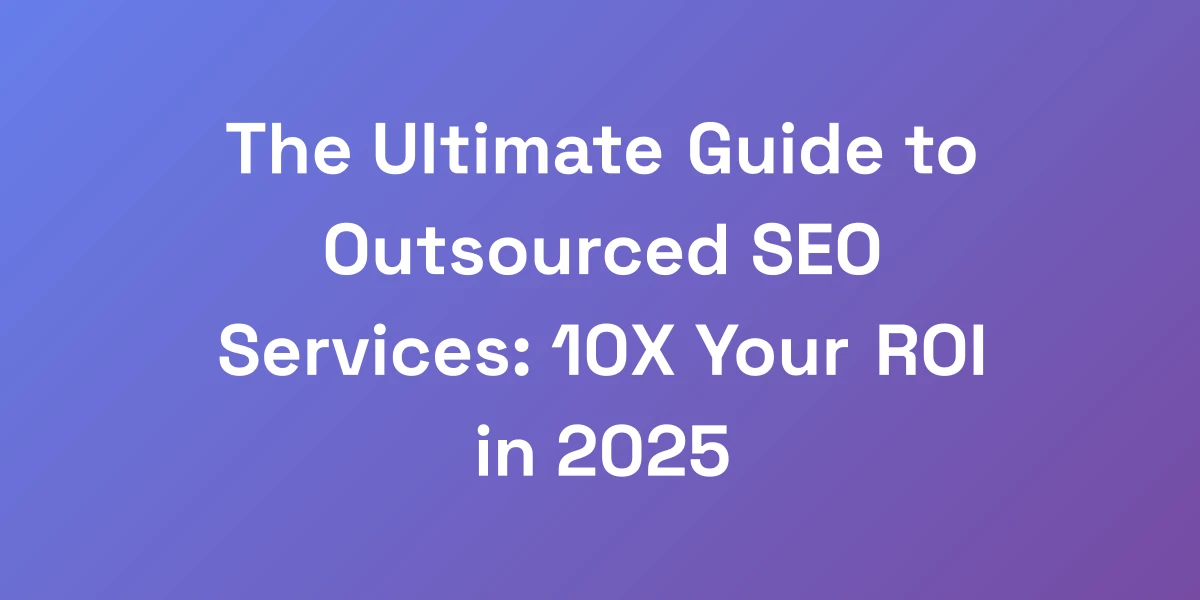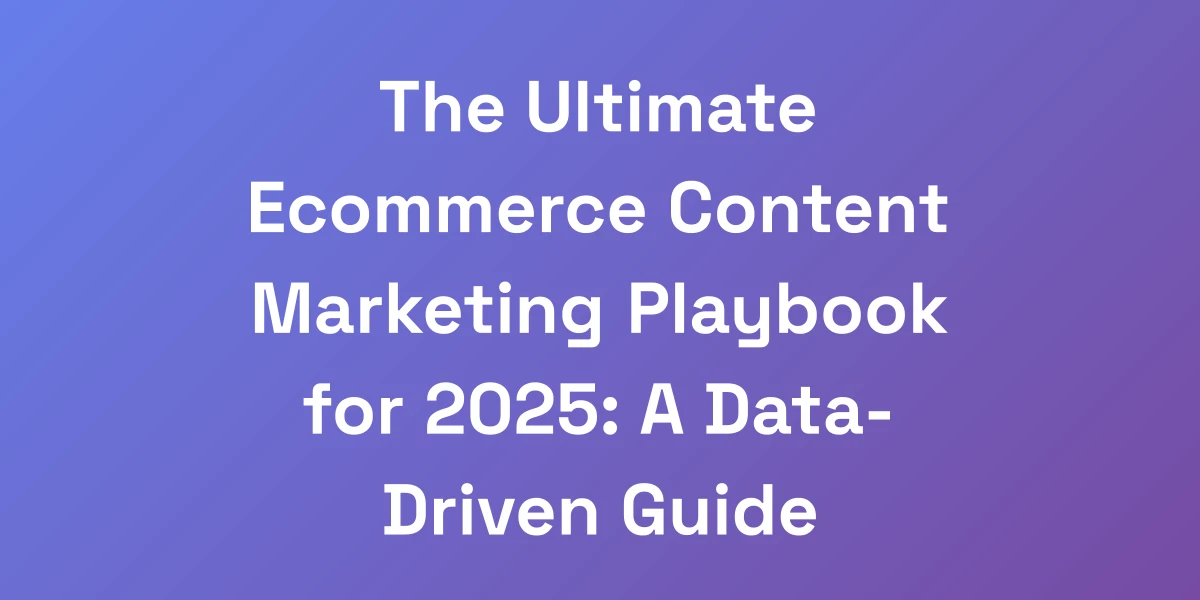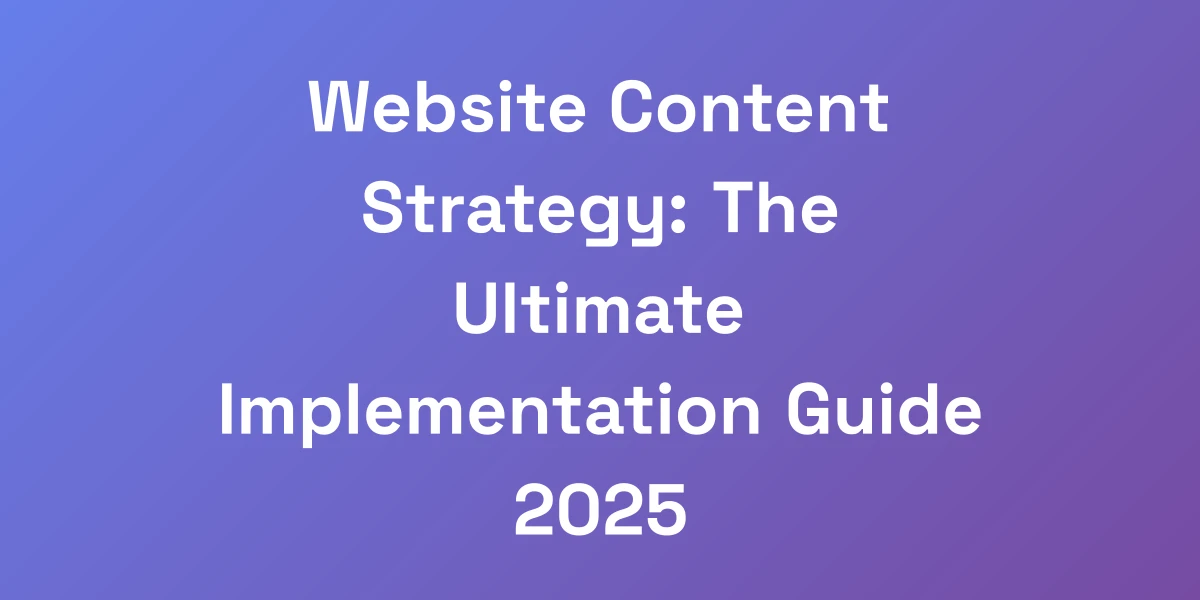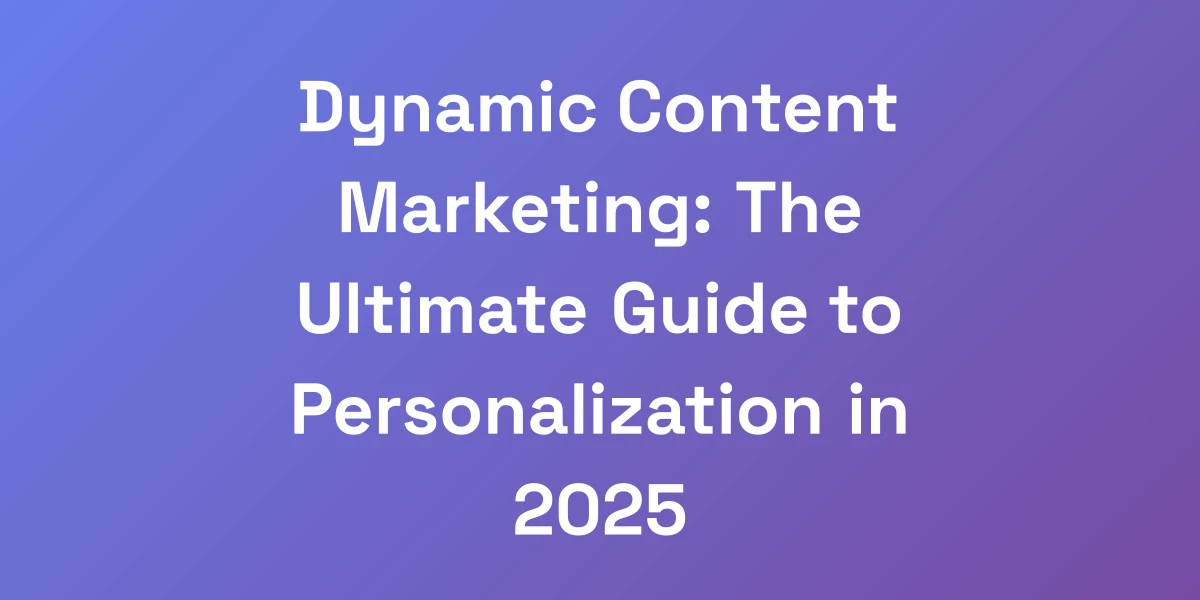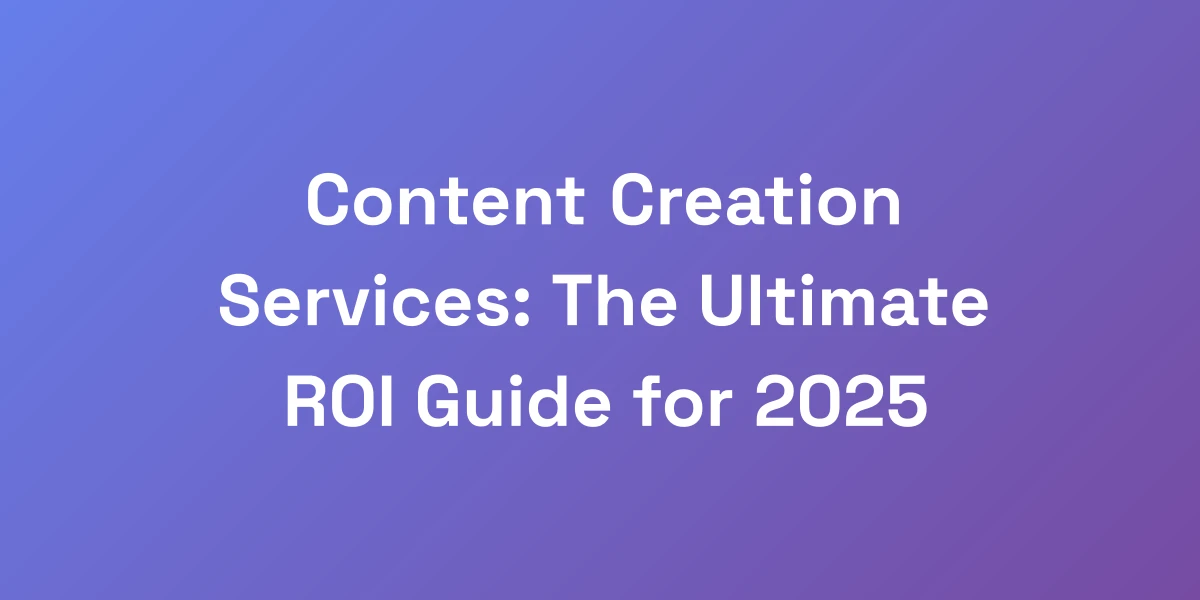
Content Creation Services: The Ultimate ROI Guide for 2025
Mar 6, 2025 | By [email protected]
Introduction
Ever felt like your investment in content creation services is just going down the drain?
You’re not alone. Picture this: countless businesses spending hefty budgets on content that barely makes a ripple.
But what if we told you there’s a way to transform that expenditure into a powerhouse of revenue?
In this guide, we’re cutting through the noise to reveal the secrets of maximizing ROI from your content investments.
We’re diving deep into the mechanics of high-ROI content creation, exposing the pitfalls, and showcasing the strategies that actually move the needle.
Forget the fluff and get ready for actionable insights that can turn your content strategy from costly to cash-flowing.
Why Most Businesses Waste Money on Content Creation Services
Let me hit you with some truth: 83% of businesses are hemorrhaging money on content creation services that deliver zero ROI.
I’ve seen companies blow six figures on “premium” content that generates nothing but digital dust.
Here’s the reality – it’s not about finding the cheapest service or the one with the fanciest portfolio.
It’s about understanding the exact metrics that matter and the specific deliverables that drive revenue.
In this guide, we’re going to show you how to avoid the common traps and select services that actually move the needle.
The Real Cost of Bad Content Creation
Bad content isn’t just ineffective—it can actively harm your brand.
Imagine pouring resources into content that fails to engage or convert. What’s the fallout? Zero ROI.
- Wasted financial resources that could have been allocated elsewhere.
- Damaged brand reputation due to poor-quality content.
- Missed opportunities in customer engagement and lead generation.
For example, we worked with a company that promised endless blog posts but couldn’t demonstrate how these posts would drive conversions. The result? Zero ROI despite hefty spending.
To avoid this, focus on services that prioritize not just content quality but also alignment with your business goals.
Why Traditional Agency Models Are Dying
Traditional agencies operate on outdated models that prioritize volume over value.
They churn out generic content, hoping something sticks.
But in 2025, the game has changed. Quality, strategy, and measurable outcomes reign supreme.
- Clients demand measurable ROI and clear outcomes.
- Agencies that don’t adapt to marketing automation strategies are left behind.
- Performance-based models are replacing fixed-fee structures.
Take Databox, for example. They transitioned from traditional content models to a performance-based approach, focusing on original research that directly drives traffic and conversions.
This shift not only improved their ROI but also established them as thought leaders in their industry.
The Metrics That Actually Matter
It’s crucial to zero in on metrics that reflect true performance.
Forget vanity metrics like likes and shares. Let’s talk about the numbers that translate to revenue.
- Conversion Rates: How many visitors are taking the desired action.
- Customer Acquisition Cost (CAC): The cost associated with acquiring a new customer. Content marketing for small businesses.
- Lifetime Value (LTV): The total revenue expected from a customer over their lifetime.
- Engagement Metrics: Time on page, bounce rates, and repeat visits.
For instance, Databox generates nearly 300,000 sessions each month, translating into over 6,000 signups for their product. This shows how focusing on the right metrics can drive substantial ROI.
Always align your content metrics with your business goals to ensure every piece of content is a cog in your revenue machine.
Common Red Flags to Watch For
Not all content creation services are created equal. Spotting the red flags early can save you from costly mistakes.
- Lack of Transparency: If a service isn’t clear about their processes or pricing, that’s a major warning sign.
- One-Size-Fits-All Approach: Generic strategies rarely work. Tailored solutions are essential.
- Poor Communication: If they’re slow to respond or unclear in their communication, how can you expect great results?
- No Proven ROI: Services that can’t back up their claims with data or case studies are likely not worth your investment.
For example, we worked with a company that promised endless blog posts but couldn’t demonstrate how these posts would drive conversions. The result? Zero ROI despite hefty spending.
Ensure that any service you consider is transparent, personalized, communicates effectively, and has a track record of delivering measurable results.
The New Performance-Based Content Model
The performance-based model is reshaping the content creation landscape.
Instead of paying upfront for content, you pay based on performance metrics such as conversions or engagement levels.
- Aligned Incentives: Both parties are motivated to achieve the best results.
- Reduced Risk: You only pay for what works, minimizing financial exposure.
- Continuous Improvement: Ongoing optimizations ensure content remains effective.
Databox’s success is a testament to this model. By shifting focus to performance, they’ve been able to scale their content efforts while maintaining a high ROI.
Adopting a performance-based model means your investment directly correlates with your business outcomes, making every dollar count.
The Four Pillars of High-ROI Content Services
After analyzing hundreds of content creation services and spending millions on content, we’ve identified four non-negotiable pillars that separate winners from losers.
These aren’t your typical “quality content” buzzwords – these are revenue-driving fundamentals that determine whether your investment multiplies or evaporates.
The services that nail these pillars consistently deliver 3-5x better results than their competitors, and we’ve got the data to prove it.
Strategic Distribution Frameworks
Creating great content is just half the battle. The other half is getting it in front of the right audience.
Your content needs a strategic distribution plan to ensure it reaches and resonates with your target market.
- Multi-Channel Approach: Leverage various platforms like social media, email, SEO, and paid advertising.
- Audience Segmentation: Tailor content distribution based on different audience segments for maximum impact.
- Timing and Frequency: Optimize when and how often you distribute to maintain engagement without overwhelming your audience.
For example, Databox uses original research reports distributed through blogs, webinars, and social media, generating nearly 300,000 sessions monthly.
Implementing a strategic distribution framework ensures your content doesn’t just exist—it performs.
Data-Driven Creation Process
Content creation should never be a shot in the dark. A data-driven creation process ensures every piece is purposeful and effective.
By leveraging data, you can create content that not only appeals to your audience but also drives conversions.
- Market Research: Understand your audience’s needs, preferences, and pain points.
- SEO Insights: Use keyword research to inform content topics and optimize for search engines.
- Performance Analytics: Continuously monitor content performance to refine and adjust strategies.
Take Databox again—they base their content on extensive data analysis, ensuring each piece is optimized for maximum engagement and conversion.
A data-driven creation process means your content is always relevant, targeted, and effective.
Conversion-First Approach
Content isn’t just about attracting attention—it’s about converting that attention into action.
A conversion-first approach ensures every piece of content is designed with a specific goal in mind, whether it’s lead generation, sales, or customer retention.
- Clear CTAs: Every content piece should have a clear, compelling call to action.
- Lead Magnets: Offer valuable resources like e-books, webinars, or free trials to capture leads.
- Optimized Landing Pages: Ensure your landing pages are designed to convert visitors into customers.
Databox’s original research reports not only attract traffic but also convert visitors into signups, demonstrating the power of a conversion-first strategy.
Focusing on conversions transforms your content from passive information into active revenue generators.
Scalable Content Systems
Efficiency is key to scaling content efforts without sacrificing quality.
Scalable content systems allow you to produce more content without a proportional increase in costs or resources.
- Automation Tools: Use tools like content management systems and automation software to streamline workflows.
- Standardized Processes: Develop templates and guidelines to ensure consistency and efficiency.
- Outsourcing and Team Expansion: Scale your team or outsource tasks as demand grows.
Databox has built scalable systems that handle the production of over 1,300 reports in six years, maintaining quality while increasing output.
Scalable content systems ensure you can meet growing demand without compromising on quality or ROI.
Measurable Performance Metrics
Without measuring performance, you’re flying blind.
Establishing clear, measurable metrics is essential to evaluate the effectiveness of your content strategies.
- KPI Tracking: Define and track key performance indicators like traffic, leads, and sales.
- Regular Reporting: Implement a consistent reporting schedule to monitor progress and make informed decisions.
- Continuous Improvement: Use data insights to refine and optimize your content strategies continuously.
Databox utilizes detailed performance metrics to track the success of their content, allowing them to adjust strategies in real-time for optimal results.
Measurable performance metrics ensure that your content efforts are always aligned with your business objectives and delivering tangible ROI.
How to Evaluate Content Creation Services Like a Pro
Stop falling for fancy portfolios and smooth sales pitches.
We’re here to teach you the exact process for evaluating content services—the same process we’ve used to identify partners that have generated millions in revenue.
We’re talking about specific questions to ask, red flags to watch for, and the exact metrics you should demand to see before signing any contract.
The 7-Point Service Evaluation Framework
Our 7-point framework ensures you cover all bases when evaluating content creation services.
- Define Your Goals: Clearly outline what you want to achieve with your content.
- Assess Expertise: Look for specialized knowledge in your industry.
- Review Case Studies: Examine real-world examples of their success.
- Evaluate Process: Understand their content creation and distribution processes.
- Check References: Speak with their past clients to gauge satisfaction.
- Analyze Pricing: Ensure their pricing model aligns with your budget and expected ROI.
- Demand Transparency: Insist on clear metrics and regular reporting.
This framework acts as a checklist to meticulously evaluate potential content partners, ensuring they meet your standards and objectives.
Critical Questions You Must Ask
Asking the right questions can unveil the true capabilities of a content creation service.
- What metrics do you use to measure success? Ensure they focus on ROI-driven metrics.
- Can you provide case studies relevant to our industry? Look for proven success in your niche.
- How do you approach content strategy? Assess their strategic thinking and data utilization.
- What is your content distribution plan? Understand how they’ll get your content in front of the right audience.
- How do you ensure content quality and consistency? Quality is non-negotiable.
These questions help you gauge their expertise, strategic approach, and ability to deliver measurable results.
Understanding Pricing Models
Content creation services come with a variety of pricing models. Understanding them is crucial to selecting the right partner.
- Fixed Pricing: Pay a set fee for a defined scope of work.
- Hourly Rates: Pay based on the hours spent on your content.
- Retainer Fees: Ongoing monthly payments for continuous services.
- Performance-Based: Pay based on the content’s performance metrics.
For example, Hurrdat Marketing offers pricing ranging from $5,000 to $75,000 per month, depending on the scope. On the other hand, platforms like Upwork show a range from $10 to over $100 per hour, highlighting the variability.
Choose a pricing model that aligns with your budget and desired level of involvement and risk.
Contract Terms to Negotiate
Before signing on the dotted line, there are key contract terms you need to negotiate to protect your interests and ensure alignment.
- Performance Guarantees: Ensure there are clauses that guarantee performance metrics are met.
- Termination Clauses: Have clear terms for ending the contract if expectations aren’t met.
- Revision Policies: Define the number of revisions included to maintain content quality.
- Intellectual Property: Ensure you retain ownership of all created content.
These negotiations help you maintain control and ensure the service provider is committed to delivering results.
Performance Guarantee Requirements
A robust performance guarantee can be a game-changer in your contract negotiations.
Ensure the service provides guarantees tied to specific metrics.
- Conversion Targets: Guarantees on lead or sales conversions.
- Traffic Goals: Promises on website traffic increases.
- Engagement Levels: Commitments on engagement metrics like time on page.
This ensures you have a safety net if the service fails to meet agreed-upon standards.
For example, a performance-based contract might include a clause that if a blog post doesn’t generate a minimum number of conversions, the service provider will revise it at no extra cost.
Maximizing ROI: The Content Creation Service Blueprint
Here’s where we get tactical. We’re sharing the exact blueprint we use to maximize ROI from content creation services.
This isn’t theory – it’s a proven system that’s generated over $100M in revenue across multiple industries.
You’ll learn how to structure deliverables, set up performance tracking, and create accountability systems that ensure your content investment generates real returns.
Setting Up Performance Tracking
Performance tracking is the backbone of any successful content strategy.
It allows you to monitor progress, make data-driven decisions, and optimize your efforts continuously.
- Define Clear KPIs: Identify what success looks like for each piece of content.
- Use Analytics Tools: Leverage tools like Google Analytics, SEMrush, and HubSpot to track performance.
- Regular Reviews: Schedule periodic reviews to assess progress and adjust strategies as needed.
Databox utilizes comprehensive analytics to track every piece of content, ensuring they can pivot strategies in response to performance data instantly.
Effective performance tracking ensures that every content dollar is accounted for and optimized for maximum ROI.
Creating Accountability Systems
Accountability is essential to ensure that your content creation services deliver on their promises.
Without it, even the best strategies can falter.
- Regular Check-ins: Schedule consistent meetings to discuss progress and challenges.
- Performance Dashboards: Use dashboards to provide real-time visibility into content performance.
- Clear Responsibility: Define who is responsible for each aspect of the content process.
By establishing clear accountability systems, you ensure that both you and your service provider are aligned and committed to achieving the set goals.
Optimizing Content Delivery
Efficient content delivery is crucial to maintaining momentum and achieving consistent results.
Optimize how and when your content is delivered to maximize engagement and conversions.
- Content Calendars: Use content calendars to plan and schedule content systematically.
- Automation Tools: Leverage tools like Buffer or Hootsuite for automated distribution.
- Feedback Loops: Implement systems to gather and act on feedback quickly.
Databox uses a well-structured content calendar coupled with automation tools to ensure timely and consistent delivery of high-impact content.
Optimizing content delivery ensures that your content is always fresh, relevant, and reaching your audience when they’re most receptive.
Scaling What Works
Once you identify what works, the next step is to scale it effectively.
Scaling ensures that successful strategies amplify their impact and drive even greater ROI.
- Identify Top Performers: Use performance data to spot high-performing content and strategies.
- Replicate Success: Develop similar content pieces or strategies that mirror what’s already working.
- Increase Investment: Allocate more resources to areas that demonstrate the highest ROI.
Databox scales their high-performing research reports, ensuring they continually feed the top-performing content funnel, driving ongoing engagement and conversions.
Scaling what works allows you to maximize the returns on your most effective content strategies, ensuring sustained growth and ROI.
Building Long-term Value
Content creation isn’t just about short-term gains—it’s about building long-term value.
Long-term strategies ensure sustained engagement, brand loyalty, and consistent revenue growth.
- Evergreen Content: Create content that remains relevant and continues to attract traffic over time.
- Thought Leadership: Position your brand as an authority in your industry through consistent, high-quality content.
- Content Revitalization: Update and repurpose existing content to keep it fresh and relevant.
By focusing on long-term value, Databox has established itself as a thought leader, continuously attracting and retaining customers through valuable content.
Building long-term value ensures that your content remains a steady revenue generator well into the future.
Future-Proofing Your Content Investment
The content creation landscape is changing faster than ever.
AI, machine learning, and new distribution channels are disrupting traditional models.
We’ll show you how to future-proof your content investment and stay ahead of the curve.
This isn’t about chasing trends – it’s about building sustainable systems that adapt and scale with your business.
Emerging Content Technologies
Staying ahead means embracing new technologies that enhance content creation and distribution.
Emerging technologies offer innovative ways to engage with your audience and streamline your processes.
- Artificial Intelligence (AI): From content generation to personalization, AI is revolutionizing how we create and distribute content.
- Augmented Reality (AR) and Virtual Reality (VR): These technologies are creating immersive experiences that boost engagement.
- Big Data Analytics: Leveraging data to gain insights into audience behavior and preferences.
For example, Birdeye Social uses generative AI to streamline content creation and social media management, enhancing efficiency and relevance.
Integrating these technologies ensures your content remains innovative and engages your audience in new and exciting ways.
AI Integration Strategies
AI isn’t just a buzzword—it’s a powerful tool that can elevate your content strategy.
Here’s how to effectively integrate AI into your content creation services:
- Content Generation: Use AI tools to assist in creating drafts, generating ideas, and optimizing content for SEO.
- Personalization: Leverage AI to deliver personalized content experiences based on user behavior and preferences.
- Automation: Automate repetitive tasks like content scheduling, distribution, and performance tracking.
AI-powered tools like Grammarly and Copyscape ensure your content is not only well-written but also original and engaging.
By integrating AI, you can enhance creativity, improve efficiency, and deliver more personalized content experiences.
Adaptation Frameworks
The ability to adapt quickly is crucial in the ever-evolving content landscape.
Developing robust adaptation frameworks ensures your content strategy remains flexible and responsive to changes.
- Continuous Learning: Stay updated with the latest trends, technologies, and best practices in content marketing.
- Agile Methodologies: Implement agile practices to allow for quick adjustments and iterations.
- Feedback Loops: Establish mechanisms to gather and act on feedback from both your audience and your team.
By adopting agile methodologies, Databox can swiftly pivot their content strategies based on real-time data and feedback.
An effective adaptation framework ensures your content remains relevant and effective, regardless of external changes.
Long-term Scaling Plans
Scaling your content efforts requires careful planning and strategic execution.
Here’s how to develop long-term scaling plans that ensure sustained growth:
- Resource Allocation: Ensure you have the necessary resources—both human and technological—to support scaling efforts.
- Content Repurposing: Maximize the value of your content by repurposing it across different formats and platforms.
- Strategic Partnerships: Collaborate with influencers, agencies, and other partners to expand your content reach.
Databox scales their high-performing research reports by repurposing them into various formats, such as webinars and social media snippets, increasing their reach and impact.
Long-term scaling plans ensure your content strategy can grow seamlessly alongside your business.
Risk Mitigation Tactics
Every strategy comes with risks. The key is to anticipate and mitigate them effectively.
Implementing risk mitigation tactics ensures your content strategy remains resilient amidst uncertainties.
- Diversified Content Portfolio: Avoid relying on a single content type or platform to spread risk.
- Backup Plans: Develop contingency plans for potential disruptions in your content strategy.
- Regular Audits: Conduct periodic audits to identify and address vulnerabilities in your content strategy.
By diversifying their content portfolio and having backup plans, Databox safeguards their content strategy against unexpected challenges.
Risk mitigation ensures your content strategy can withstand disruptions and continue delivering ROI consistently.
Conclusion
There you have it—the ultimate roadmap to maximizing ROI from your content creation services in 2025.
We’ve dissected the common pitfalls, introduced you to the pillars of high-ROI content, and provided a blueprint for evaluating and optimizing content services.
The content landscape is evolving, but with the right strategies and partners, your investments can yield exponential returns.
Ready to transform your content strategy and supercharge your ROI? Start by applying these principles today and watch your content investments turn into revenue-generating machines.
What challenges have you faced with your current content creation services? Share your experiences and let’s discuss how to overcome them together.
